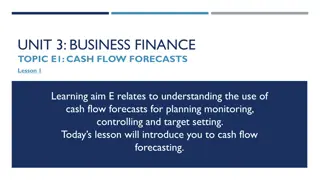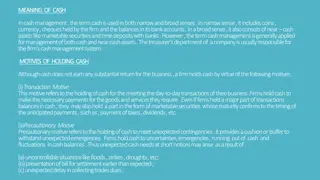Cash Management Case Study: Republic of Kosovo's Treasury Operations
Explore the cash management practices and treasury operations of Kosovo's State Treasury, highlighting its responsibilities, organizational structure, revenue, expenditures, primary balance, and cash flow forecasting methods. Learn about the budget organization's cash flow preparation process, fund allocation into the Kosovo Financial Management Information System, and the consolidated budget cash flow forecasting. Discover key financial indicators such as GDP, inflation rate, population demographics, and unemployment rate of Kosovo.
Download Presentation

Please find below an Image/Link to download the presentation.
The content on the website is provided AS IS for your information and personal use only. It may not be sold, licensed, or shared on other websites without obtaining consent from the author.If you encounter any issues during the download, it is possible that the publisher has removed the file from their server.
You are allowed to download the files provided on this website for personal or commercial use, subject to the condition that they are used lawfully. All files are the property of their respective owners.
The content on the website is provided AS IS for your information and personal use only. It may not be sold, licensed, or shared on other websites without obtaining consent from the author.
E N D
Presentation Transcript
Cash Management Cash Management Case of Republic of Kosovo Case of Republic of Kosovo VIENNA, PEMPAL TREASURY TCOP VIENNA, PEMPAL TREASURY TCOP NOVEMBER 2018 NOVEMBER 2018
Kosovo Fact Sheet Independence date 17.02.2008 Official currency EURO GDP (end of 2017) - EUR 6.2 billion Inflation (end of 2017) - 1.5% Estimated population 1.74 million Of which 58% is below 30 years old Unemployment rate 30.5%
Kosovo Treasury Kosovo State Treasury responsibilities are split into four main so called functions: - - - - Cash and Debt Management Operations and System Management Accounting, Reporting and Monitoring IT and Administration Support - Payroll Management (Over 88,000 public servants) - extended role of Treasury
Cash Flow Forecasting Forecast of Revenues & Annual, Monthly Expenses Forecast 1.0 Budget Organizations In the beginning of the fiscal year, each Budget Organization (BO) prepares its cash flow as per their annual budget appropriations set by Annual Budget Law. BOs Cash Flows are prepared per Program/Department level and broken down type/category of expenses. Cash Flows are at monthly basis for the whole fiscal year. BOs Cash Flows are submitted to the Cash Management Division by end January. Cash Management Division technically allocates the funds into KFMIS (Kosovo Financial Management Information System) into a monthly and per quarter basis (depending from the type of exepn. )
Cash Flow Forecasting cont. 2.0 Consolidated Budget Cash Flow Cash management Unit prepares a consolidated budget cash flow for the whole year at monthly level. A Consolidated Cash Flow reflects the forecast of revenue collection per type of revenue, as well as expenses per category level. Forecasts for tax and non-tax revenue collection are taken from the two largest collection organizations while other type of revenue/income are done based on a historical forecast. Forecast for Expenditure side are done based on historical expenditure as well as macroeconomic condition, policy is taken into account (wage increase, inflation, big capital projects etc) .
Cash Forecast 1. Who is responsible for forecasting government cash flows and aggregate cash balances? How accurate are the forecasts? How often are forecasts prepared, and for what period are these calculated? Forecasts of Government Cash Flows and forecasts of balances for the government are prepared by Cash Management Unit, and discussed jointly with Macroeconomic Department within the MF. Based on the data on which the forecast was prepared, the forecasts so far have been very accurate. The forecasts prepared in the beginning of the year are updated on a monthly basis (after the end of each month). 2.How do you collect information on cash revenue and expenditure from other departments (tax administration, budget department, line ministries, other public entities)? At the beginning of the year, Cash Management Unit requires from Tax Administration and Customs to send the monthly forecasts for the collection of their revenues for the whole year. Some type of revenues forecasted in the Budget, are taken from Macro Unit within MoF and some types of revenues are done on historical forecasts.
Cash Forecast cont. 3. How do you compare the forecasts with the actual outcomes? Has the accuracy of the cash flow forecasts been improved during the last year? If not, what are the causes for the inaccuracy? Since 2003, Kosovo has been using the Canadian Program KFMIS ( the system for Kosovo Finance Management / FreeBalance), program where all incomes and expenditures are recorded in, so KFMIS enables us to have the monthly data actual on a monthly basis and compare with them the forecast with the current. The forecast remains as a historic one, but there have been cases especially in expenses, that there have been made interventions in the forecast. We mark it as accurate. As recommended by DeMPA (a World Bank assessment for debt management), we re planning to switch to daily cash flow forecast. 4. How is the short-term issuance program developed? Is it linked to cash balance forecasts? Kosovo is in the Eurozone and as such has no monetary policy. Therefore, an issuance program is prepared based on the budget deficit financing needs identified in the budget law, considering the keep of a solid end year bank balance (4.5% of GDP).
Cash Forecast cont. 5. Has the government set a target or range for the balance in the government bank account? If so, what is the range, and who decided this range? The daily balance sheet in the account must be 50 mln according to the Treasury Investment Policy. 6. Who monitors that the cash balance is within the determined range, and which actions are taken to ensure that the cash balance is within this range? How often are actions taken to keep the cash balance within the determined range? The account balance is monitored by the Treasury as it is a budget executor. So far the banking balance has been kept at the required level and hasn t been put at risk. 7.How is the coordination between debt and cash managers? Is it formally institutionalized? Are they integrated in a single unit? Within Treasury, a cash and debt management are under one function, under Deputy Treasurer for cash and debt management.
8. Does the central bank pay interest on surplus balances? If so, is the interest rate linked to market rates? Cash Forecast cont. Central Bank pays an interest rate on the total funds held at accounts. The Interest Rate is set by the Board of Central Bank for the whole its clients. 9. Is the government able to invest surplus balances? If so, which investments are used? Central Bank acts as an asset manager of Kosovo Budget funds held at Treasury Single Account and its sub-accounts. Investments of cash surplus are invested as per Investment Policy signed between Treasury and Central Bank. As of 2015, the surplus has not been invested due to financial unfavorable conditions in international market. 10.Which instruments are used for short-term borrowing? Up to 1y, currently six months T-bills and 12 months T-bills.
Future plans 1. Cash management reform: - We have received an approval for a grant support from the Word Bank fund - In addition to other issues, we will be focused on methodology of cash forecasting, capacity building with technical assistance, training materials and manuals, IT system/software upgrade to adopt those changes to KFMIS - Review of investment policy according to cash management reform result 2. Changes on the legislation (Law) on debt management - Possibility of short-term financing (MoF to Municipalities) based on cash flow deficits forecasted - Flexibility on borrowing on internal money market






















